|

 Up
Up 
 Wright Flyer I
Wright Flyer I 
(You are here.)



  Need
to Need
to
find your
bearings?
Try
these
navigation aids:
If
this is your first
visit, please stop by:
Something
to share?
Please:



|
|
Available in Française, Español, Português, Deutsch, Россию,
中文,
日本, and others.
 fter
a failed attempt on 14 Dec 1903 by Wilbur, the Wrights flew the world's first powered
airplane at Kitty Hawk on 17 Dec 1903. Beginning at 10:35 AM, Orville flew it about
120-feet or 36.5 meters (in about 12 seconds. Then Wilbur flew for about 175 feet
or 53.3 meters, followed by Orville who flew about 200 feet or 60.9
meters. Finally
about 12:00 PM, Wilbur flew 852 feet or 259.7 meters in 59 seconds. fter
a failed attempt on 14 Dec 1903 by Wilbur, the Wrights flew the world's first powered
airplane at Kitty Hawk on 17 Dec 1903. Beginning at 10:35 AM, Orville flew it about
120-feet or 36.5 meters (in about 12 seconds. Then Wilbur flew for about 175 feet
or 53.3 meters, followed by Orville who flew about 200 feet or 60.9
meters. Finally
about 12:00 PM, Wilbur flew 852 feet or 259.7 meters in 59 seconds.
The
Flyer I had a wooden frame in which the straight parts were spruce
and the curved parts ash. The frame was covered with a finely-woven
cotton cloth and was sealed with "canvas paint" similar to what
sailors in Kitty Hawk used on their sails, probably paraffin
dissolved in kerosene. The metal fittings were made from mild steel
and the aircraft was rigged with15-gauge bicycle spoke wire. The
engine block was cast from a hard aluminum alloy, 92% aluminum and
8% copper. The other parts of the engine were made from steel or
cast iron, with the exception of the spark points which contained
tiny bits of platinum.
Like the 1902 Glider, the Flyer I had three-axis control and was
the first powered aircraft to be so equipped. The wings twisted or
"warped" to roll the aircraft from side to side. The elevator
(in front of the wings) pitched the aircraft nose-up and
nose-down, The rudder (behind the wings) yawed the aircraft
right and left. As in the 1902 Glider, the roll and yaw controls
were interconnected -- when the pilot moved a cradle in which his
hips rested from side to side, the wings warped and the rudder
pivoted. The elevator was actuated by a lever to the pilot's left.
The Flyer I specifications:
- 40.3 ft (12.2 m) wingspan
- 0.83 ft (25 cm) anhedral
- 6.5 ft (198 cm) chord
- 6.2 ft (189 cm) separation
- 510 sq ft (47.4 sq. m) wing area
- 1:20 camber
- 48
sq ft (4.6 sq m) double front elevator (referred to as "horizontal rudder"
by the Wrights
- 21 sq ft (1.9 sq m) twin movable vertical rear rudders
- 21.1 ft (6.4 m) overall length
- 605 lb (274.4 kg) total weight (without pilot)
- 4 cylinder engine, 12 hp at 1150 rpm
- Two contra-rotating propellers, 8 ft (244 cm) long, turning
at 350 rpm
The engine (on the right side of the centerline) weighed 170 lbs.
or 77.1 kg. The pilots (who lay on the left side of the centerline)
weighed just 145 lbs. or 65.8 kg. To compensate for this imbalance,
they made the right wing 4 inches (10 cm) longer so that it would
produce slightly more lift than the left.
This was the only aircraft the Wrights tried to preserve. Damaged by wind after 4th
flight, they returned it to Dayton; Orville restored it in 1916 and sent it to
the Kensington Science Museum in London, England in 1928. It was returned to
the United States in 1948 and
since 1949 the Smithsonian has displayed it as the world's first piloted powered airplane.
The plaque reads: "THE ORIGINAL WRIGHT BROTHERS AEROPLANE: The world's first
power-driven, heavier-than-air machine in which man made free, controlled and sustained
flight, invented and built by Wilbur and Orville Wright flown by them at Kitty Hawk, North
Carolina December 17, 1903. By original scientific research the Wright Brothers discovered
the principles of human flight as inventors, builders, and flyers they further developed
the aeroplane, taught man to fly, and opened the era of aviation."
References:
- McFarland, 1953, pp , 394-397, 1183, plates 60, 63-78.
- McFarland, Marvin W. (ed) The papers of Wilbur and Orville Wright. McGraw-Hill
Book Co., New York, 1953, pp 394-397, 1183, plates 60, 63-78.
[Submitted by Joe W. McDaniel] |
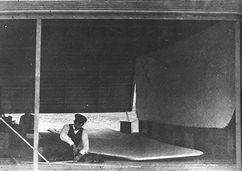
Wibur and Orville assembling the 1903 Fyler I at their camp in Kitty
Hawk, NC.
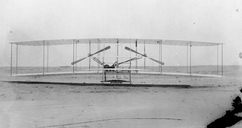
A front view of the Flyer.
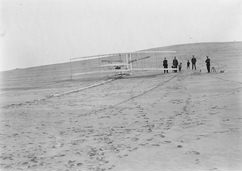
Ready for the first flight test on 14 December 1903.
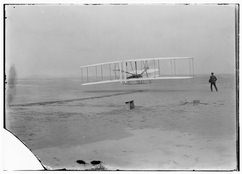
Rarely seen in its entirety, this is a print of the complete
photograph taken of the first flight on 17 December 1903.
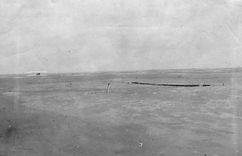
On its fourth flight, the Flyer traveled 852 feet (259.7 meters)
from its starting point and remained aloft for 59 seconds. The
Wright brothers considered this the only completely successful
flight of the day.
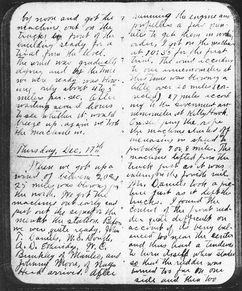
The entry in Orville's diary for 17 December 1903.
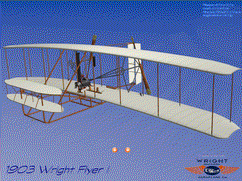
Want to see a detailed digital model of the Flyer from any angle?
CLICK
HERE to download the WBAC Wright Flyer I 3D PDF (about 11.8 Mb).
(Your browser must have an up-to-date
Adobe Reader plug-in to view the model.) After loading the PDF
file, choose "Enable all features" to display the Flyer and the
viewing tool bar.
|
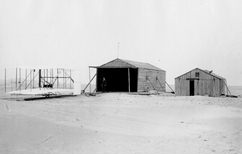
The assembled Flyer outside its hangar. Wilbur is looking out of the
door.
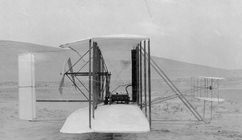
The Flyer from the right side.
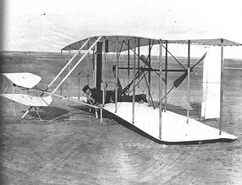
Although the airplane left the ground on December 14, the pilot
(Wilbur) never had the airplane under control and the flight ended
in a crash that broke the front elevator.
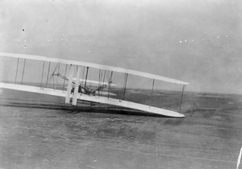
The wing dips during the third flight on 17 December 1903.
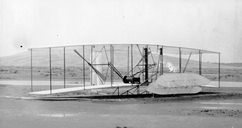
The Flyer landed hard at the end of the fourth flight and broke the
front elevator again.
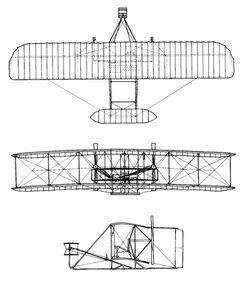
Top view, font view, and side view drawings of the Flyer I. For more
drawings, click
HERE.
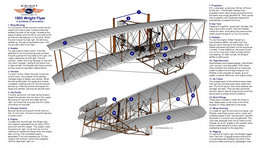
For an illustration (in PDF format) that identifies and explains the
parts of the 1903 Wright Flyer,
click HERE.
|